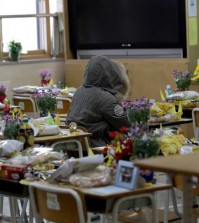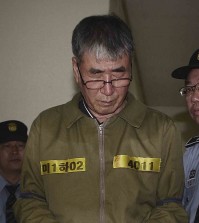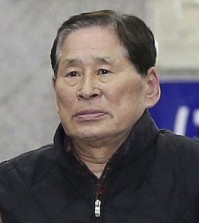- California Assembly OKs highest minimum wage in nation
- S. Korea unveils first graphic cigarette warnings
- US joins with South Korea, Japan in bid to deter North Korea
- LPGA golfer Chun In-gee finally back in action
- S. Korea won’t be top seed in final World Cup qualification round
- US men’s soccer misses 2nd straight Olympics
- US back on track in qualifying with 4-0 win over Guatemala
- High-intensity workout injuries spawn cottage industry
- CDC expands range of Zika mosquitoes into parts of Northeast
- Who knew? ‘The Walking Dead’ is helping families connect
What caused the Korean chopper to crash?

Firefighters work at the site of a helicopter crash that killed all five firefighters onboard in a residential area of Gwangju, Thursday. (Yonhap)
By Jung Min-ho
Speculation abounds about what caused a firefighting helicopter to crash in the southwestern city of Gwangju on Thursday, killing all five on board including two skilled pilots.
According to one witness, the chopper was flying at a low altitude and caught fire before it plummeted to the ground.
The reason is unclear why it flew at a low altitude. It was supposed to fly at 7,000 feet or higher because it was rainy and foggy, according to the Air Force’s navigation control center.
The center said it told the pilot to increase altitude after finding that the chopper was flying too low. It then rose to an altitude of 3,600 feet, but soon disappeared from radar.
The center’s claims suggest that a mechanical problem might have prevented the chopper from flying at higher altitudes.
Aviation officials collected Friday the helicopter’s two black boxes, but found they were “seriously damaged. ” The boxes will be sent to France, where they were made.
The officials believe it may take about one year to fix them and determine the cause of the crash.
The chopper was a Eurocopter AS365N3 or Dauphin, a model the National Emergency Management Agency (NEMA) had used since 2001.
The agency ordered all the regional fire headquarters to stop using the AS365N3 and the AS365N2 models. Seven Dauphins are now in use in Korea.
According to Rep. Jin Sun-mee of the main opposition New Politics Alliance for Democracy, there are nine firefighting helicopters manufactured by Eurocopter, a French firm, in Korea.
According to the Gangwon Fire Headquarters (GFH), to which the helicopter belonged, it underwent repairs at Samsung Techwin June 23-24 after problems were found with its fuel pump, footrest, landing headlight and auxiliary oil hydraulic pump switch.
However, GFH officials said all the problems had been fixed and no other mechanical issues were detected at the time.
One mechanic told local media that the pilots also did not mention anything about mechanical problems before and after the maintenance.
“After running it for 25 hours, three mechanics checked the helicopter for the entire day. The crashed one was not old and seemed just fine,” the mechanic was quoted as saying.
The firefighters were on the way back to their headquarters in Chuncheon, Gangwon Province, after search operations for those still missing in the wake of April’s ferry Sewol disaster.
They ended the mission on Thursday earlier than planned because it was foggy and rainy. But NEMA officials noted the weather was not likely the main cause of the crash since the skies were still navigable.
Meanwhile, the NEMA sent the five corpses to the National Forensic Service.















